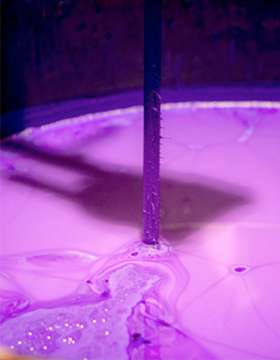Effective Partnerships
The most effective custom coatings partnerships evolve over time. As a customer’s manufacturing and performance needs change, their coatings supplier should work with them to reformulate coatings that evolve with these needs. At Aexcel, we have spent over 50 years working with our customers to create custom coatings tailored to their products and processes. A new coating need can arise for a variety of reasons, including a need to increase production efficiency in response to increased customer demand. This article explores how the right custom coatings partner can help break through production bottlenecks and capitalize on a spike in customer demand.
When a manufacturer runs into capacity constraints as a result of an uptick in business, process engineers examine the production line and recommend action steps to improve efficiency. Reducing work-in-process inventory is one of the most common recommendations from process engineers for alleviating capacity constraints. One of the first places production managers turn for reducing work-in-process inventory is their coatings line, as longer drying times delay finished goods from being packaged, stacked, or further processed. For manufacturers cure time appears to represent a zero value-added use of time. Using a coating that can deliver adequate performance while requiring minimal cure time is advantageous.
At first, most manufacturers merely speed up their paint line, often giving their coatings insufficient time to reach a full cure before packaging. Without a full cure, industrial coatings fail when the product is packaged.
Customer Issues & Resolutions
A customer came to Aexcel with this issue. The Aexcel custom coating they were using required 20 minutes at 300°F bake time for full cure. The customer wanted to achieve a full cure in 12 minutes without sacrificing any of the coating’s anti-corrosion attributes. To speed up a coating’s cure time, a custom formulator has several options, including:

- Forcing more heat on the existing coating
- Decreasing humidity in the application environment
- Applying the coating at a thinner film thickness
- Adding drying additives to the existing formula
- Reformulating with a faster drying resin system
- More Heat: Adding heat to the equation is an intuitive solution for promoting faster cure times. However, Aexcel’s chemists knew that forcing more heat onto this coating would damage polymers and volatilize other ingredients in the formulation. Thus, forcing more heat on the coating was not an optimal solution.
- Air Control: When coatings cure at ambient temperatures, controlling humidity in the area is a common method for achieving faster cure times. When coatings are baked, however, a well-designed oven usually overcomes any humidity that would impact cure time.
- Reduced Film Thickness: Applying coatings at a thinner rate can shorten cure time, but with possible performance consequences. The film thickness required to achieve the customer’s desired cure time may result in the coating being unable to provide desired anti-corrosion, hardness, mar-resistance, and overall durability. Here, where the chief enduse requirement for the coating was to provide adequate corrosion resistance, applying at a thinner film thickness would lead to more problems than it solved.
- Incorporating Additional Drying Additives: While drying additives can obviously enhance cure times, they come with a considerable cost. Here, adding a sufficient amount of compatible drying additives to the formulation drove up the cost of the coating considerably.
- Reformulation With Alternative Resin System: Aexcel recommended seeking out a new resin to allow for a compliant cure time. After utilizing expansive raw material supplier network and performing on-site testing, Aexcel arrived a coating with the desired performance and curing capabilities, utilizing a more advanced resin system.
Common Manufacturing Fears
A common fear among manufacturers considering a switch from their current industrial coating is that they will need to purchase new application equipment or reconfigure their entire line to accommodate the coating. At Aexcel, we keep these fears in mind when formulating our custom coatings. Here, despite the new urethane chemistry, the coating was a drop-in product—it could be applied and processed utilizing the same equipment as the original coating.

Although this new formulation cost slightly more than the initial coating, the customer accepted this cost because it resulted in reduced work-in-process inventory, which increased productivity, giving way to increased output that more than justified the increase in price.
Is your coatings supplier responsive in accommodating changes in your mfg requirements?
